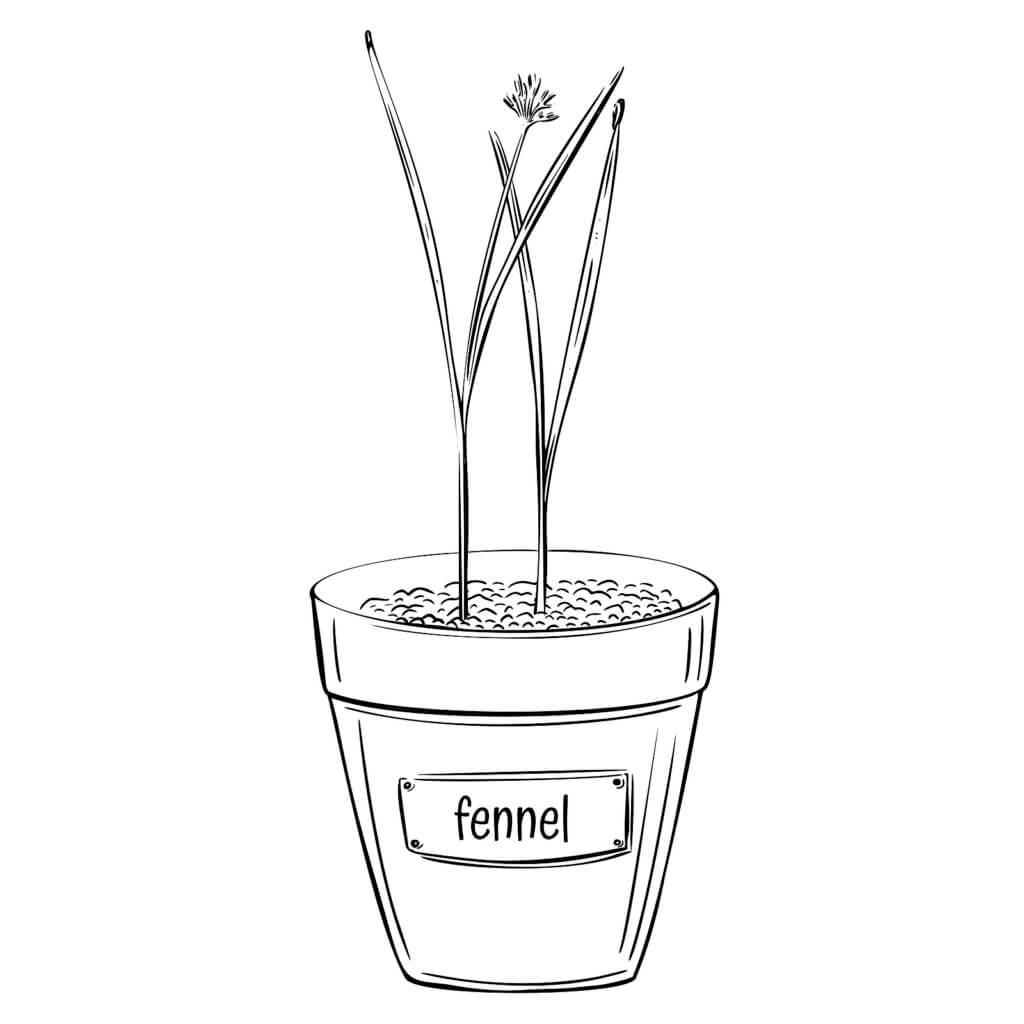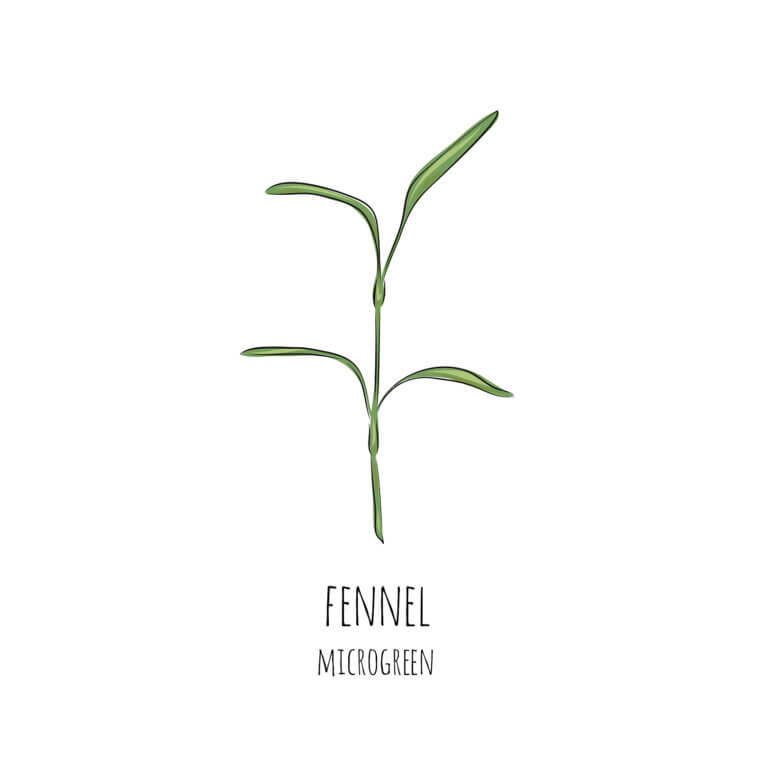Table of Contents
In recent years, I've been absolutely fascinated by the culinary world's growing obsession with microgreens. These little powerhouses of flavor and nutrition have completely captured my attention. One particular variety that has me hooked is fennel microgreens. Their distinctive taste, delightful appearance, and impressive health benefits have made them a staple in my kitchen.
So, let's take a deep dive into the captivating realm of fennel microgreens, from how to grow them to their incredible nutritional value, culinary uses, and sustainability factor. By the time we're done with this exploration, you'll be as excited as I am to incorporate fennel microgreens into your daily cooking adventures.
Understanding Fennel Microgreens
Microgreens: A Deeper Dive
Microgreens, often referred to as “vegetable confetti,” are the tender, early shoots of plants that are harvested within the first 7 to 21 days after they've sprouted. These miniature greens stand out from sprouts in that they are cultivated in soil or soil-like growing mediums, and only their delicate above-ground portions are considered edible. These tiny greens have gained popularity for their intense flavors, vibrant colors, and concentrated fennel microgreens nutritional profiles.
The Wonders of Fennel Microgreens
Fennel microgreens, a specific type of microgreen, are derived from the fennel plant, scientifically known as Foeniculum vulgare. Although fennel bulbs and seeds have enjoyed a long history in culinary traditions, fennel microgreens have emerged as a relatively recent addition to the culinary world.
These microgreens are renowned for their distinct anise-like taste and aromatic qualities, making them a prized ingredient that can elevate everyday dishes to exceptional culinary experiences. Their appearance, flavor, and versatility in cooking have made them a fascinating addition to the world of gourmet cuisine.
Check out our post on How We Grow Microgreens
Unlocking the Nutritional Potential of Fennel Microgreens
Nutritional Riches of Fennel Microgreens
Beyond their delightful flavor and visual appeal, fennel microgreens seeds are true nutritional gems, packed with a diverse array of vital nutrients. Let's delve deeper into the remarkable nutrient profile that makes these tiny greens a must-have addition to your diet:
Vitamins
Fennel microgreens are brimming with essential vitamins that play crucial roles in maintaining your overall health. They are an abundant source of:
- Vitamin A: This nutrient is essential for healthy skin, vision, and immune function.
- Vitamin C: Renowned for its immune-boosting properties, vitamin C also supports collagen production for skin and tissue health.
- Vitamin E: Known for its antioxidant prowess, vitamin E helps protect cells from oxidative damage.
- Vitamin K: Fennel microgreens contribute to your daily vitamin K intake, which is vital for proper blood clotting and bone health.
Minerals
These microgreens deliver a mineral-packed punch, with key minerals such as:
- Calcium: Crucial for maintaining strong bones and teeth.
- Magnesium: Essential for muscle function and nerve transmission.
- Potassium: Helps regulate blood pressure and fluid balance.
- Iron: Supports oxygen transport in the blood, preventing anemia.
Fibe
Fennel microgreens are a notable source of dietary fiber, which plays a pivotal role in your digestive health. Fiber aids in regular bowel movements, prevents constipation, and promotes a lasting feeling of fullness, making it an asset for weight management.
Antioxidants
These microgreens boast a variety of antioxidants, including compounds like quercetin and kaempferol. Antioxidants act as your body's defense system, protecting cells from oxidative stress and reducing the risk of chronic diseases. The presence of these antioxidants in fennel microgreens makes them a powerful addition to your diet for long-term health benefits.
The Health Benefits of Fennel Microgreens
Fennel microgreens, the young and tender shoots of fennel plants, are bursting with a wealth of nutrients and offer a wide range of health benefits. These miniature greens provide a delicious and convenient way to enhance your well-being. Here's a more detailed look at the numerous health advantages they offer:
Digestive Health
Fennel microgreens are rich in dietary fiber, which aids in promoting a healthy digestive system. The natural compounds found in these greens can effectively alleviate common digestive issues such as indigestion, bloating, and constipation.
Weight Management
If you're looking to shed some pounds or maintain a healthy weight, fennel microgreens can be your ally. Their high fiber content helps control appetite and provides a sense of fullness, supporting your weight management efforts.
Antioxidant Protection
Fennel microgreens are packed with antioxidants, including vitamins C and E, as well as various phytonutrients. These antioxidants play a vital role in combating free radicals in your body, which can help reduce the risk of chronic diseases such as cancer and heart disease.
Bone Health
To maintain strong bones and teeth, fennel microgreens offer a significant source of calcium and magnesium. These minerals are essential for bone density and overall bone health, making these greens an excellent addition to your diet.
Anti-Inflammatory Properties
Chronic inflammation is linked to various health conditions, including arthritis and allergies. Fennel microgreens contain anti-inflammatory compounds that may assist in managing and reducing inflammation, potentially providing relief for those suffering from such conditions.

Cultivating Fennel Microgreens
Selecting the Ideal Fennel Variety
Embarking on a successful journey of fennel microgreens cultivation begins with choosing the right fennel variety. It is crucial to opt for fennel varieties specifically bred for microgreen production. Two popular choices in this category are ‘Bronze Fennel' and ‘Florence Fennel,' known for their tender leaves and intense flavor profiles. Selecting the appropriate fennel variety is the first step in ensuring a rewarding microgreen growing experience.
Creating the Perfect Growing Environment
To cultivate fennel microgreens successfully, creating an ideal growing environment is paramount. Consider the following factors to optimize your microgreen cultivation setup:
- Growing Medium: Fennel microgreens thrive in well-draining soil or a soilless medium such as coconut coir or peat moss. The chosen medium should provide an optimal root environment to support healthy growth.
- Containers: Select shallow containers or trays with adequate drainage to prevent waterlogging, which can be detrimental to your microgreens. Proper drainage is essential to maintain the health of your fennel microgreens.
Seed Selection and Planting Techniques
To kickstart your fennel microgreens cultivation, follow these steps for seed selection and planting:
- Seed Preparation: Begin by soaking fennel microgreen seeds in water for 8 to 12 hours. This soaking process promotes germination and ensures a robust start for your microgreens.
- Sowing: After soaking, evenly spread the soaked seeds on the chosen growing medium. Be mindful not to overcrowd them, allowing sufficient space between seeds to ensure proper air circulation and prevent mold or fungal issues.
- Covering: Add a thin layer of soil or the selected growing medium on top of the seeds. This layer helps retain moisture and provides support for the growing microgreens.
- Watering: Water the seeds gently but thoroughly, ensuring that the growing medium remains consistently moist throughout the germination and growth phases.
Care and Maintenance Tips
While fennel microgreens are relatively low-maintenance, they do require attention to specific factors for healthy growth:
- Light: Provide adequate sunlight or artificial light for 12 to 16 hours daily. Placing your microgreens on a sunny windowsill or setting up dedicated grow lights can ensure they receive the necessary light for optimal growth.
- Watering: Maintain consistent moisture in the growing medium, being cautious not to overwater, which can lead to mold or rot issues. A gentle misting or watering at the base of the plants is advisable to prevent water-related problems.
- Temperature: Keep the cultivation area within a temperature range of 60°F to 75°F (15°C to 24°C) for ideal growth. Avoid extreme temperature fluctuations, as they can stress the microgreens and hinder their development.
Harvesting Fennel Microgreens
Knowing when and how to harvest fennel microgreens is essential to enjoy their freshness and flavor. Here's a guide on harvesting and preparing them for consumption:
- Harvest Time: Typically, fennel microgreens are ready for harvest when they reach a height of 1 to 2 inches. Use scissors or a sharp knife to cut the microgreens just above the soil line. Be careful not to damage the roots or the remaining plants during the harvesting process.
- Cleaning: After harvesting, rinse the fennel microgreens gently under running water to remove any residual soil or growing medium.
- Drying: Pat the microgreens dry with a clean kitchen towel or paper towels to remove excess moisture before using them in your culinary creations.
By following these comprehensive steps, you can cultivate and harvest fennel microgreens with confidence, elevating your dishes with their unique flavor and vibrant freshness.
Fennel Microgreens: Culinary Versatility
Incorporating Fennel Microgreens into Your Meals
Fennel microgreens, renowned for their distinctive anise-like flavor and aromatic qualities, offer an exciting array of possibilities for enhancing the taste and presentation of your meals. Dive into the world of culinary creativity with these expanded ideas on how to incorporate fennel microgreens into your dishes:
- Salads with a Twist: Transform your salads into culinary masterpieces by generously incorporating fennel microgreens. These microgreens not only impart a refreshing anise-like zest but also provide an irresistible crunch, adding depth and texture to your greens. Try them in mixed green salads, fruit salads, or grain-based salads for an unexpected burst of flavor.
- Sandwiches and Wraps: Elevate your everyday sandwiches and wraps to gourmet status by including fennel microgreens as a nutritious and flavorful garnish. Whether it's a turkey club, a veggie wrap, or a classic BLT, these microgreens bring a delightful twist to your handheld meals.
- Soups and Stews Magic: Elevate the taste and visual appeal of your favorite soups and stews by introducing a handful of fennel microgreens just before serving. Their vibrant green hues and aromatic essence infuse your hot bowls with freshness and a hint of licorice-like complexity.
- Seafood Harmony: Create a harmonious fusion of flavors by pairing fennel microgreens with seafood dishes. Whether it's grilled fish, seared scallops, or shrimp scampi, these microgreens complement the delicate flavors of seafood while adding a captivating contrast in texture and taste.
- Gourmet Garnish: Elevate your culinary presentation by using fennel microgreens as a stunning garnish. Their delicate appearance and vibrant greenery make them perfect adornments for a wide range of dishes. Sprinkle them over omelets, risottos, or grilled meats to impress both the eyes and the palate.
- Savory Sauces: Experiment with incorporating fennel microgreens into homemade sauces and dressings. Blend them into pesto, vinaigrettes, or aioli to infuse your sauces with their unique flavor, giving your dishes an extra layer of complexity.
- Beverage Enhancements: Get creative with your beverages by adding fennel microgreens to cocktails and mocktails. Garnish your drinks with a sprig of these microgreens to introduce a refreshing herbal note, turning ordinary beverages into extraordinary sips.
- Exotic Flair: Take your culinary adventures to new heights by experimenting with global cuisines. Fennel microgreens find their place in dishes like Thai curries, Indian chutneys, and Mediterranean mezzes, where their flavor and aroma add an exotic twist.
Recipes Featuring Fennel Microgreens
Fennel microgreens, with their distinctive anise-like flavor and aromatic qualities, can be a delightful addition to various dishes. Here are two recipes that showcase the versatility of these tiny greens:
- Fennel Microgreens Salad with Citrus Dressing
Ingredients:
- Fennel microgreens
- Mixed greens
- Orange segments
- Grapefruit segments
- Olive oil
- Lemon juice
- Honey
- Salt
- Pepper
Directions:
- Begin by assembling a vibrant salad with a base of mixed greens and generous amounts of fennel microgreens.
- Add fresh orange and grapefruit segments to infuse a burst of citrus flavor and brightness.
- In a separate bowl, prepare a zesty citrus dressing by whisking together olive oil, freshly squeezed lemon juice, a drizzle of honey for sweetness, and a pinch of salt and pepper for seasoning.
- Drizzle the citrus dressing over the salad, ensuring that every leaf and microgreen is coated.
- Toss the salad gently to combine all the flavors, and serve it as a refreshing and nutritious side dish or a light meal.
- Grilled Salmon with Fennel Microgreens
Ingredients:
- Salmon fillets
- Fennel microgreens
- Olive oil
- Minced garlic
- Lemon zest
- Salt
- Pepper
Directions:
- Start by grilling salmon fillets to perfection, achieving a succulent and flaky texture. Season them with a sprinkle of salt and pepper for a savory base.
- While the salmon is grilling, prepare a flavorful topping by combining fennel microgreens, a drizzle of olive oil, minced garlic for a subtle kick, and freshly grated lemon zest for brightness.
- Once the salmon fillets are cooked to your liking, generously spoon the fennel microgreens mixture over each piece.
- The heat from the salmon will slightly wilt the microgreens, releasing their aromatic flavors and infusing the dish with a burst of freshness.
- Serve the grilled salmon with fennel microgreens as a main course, accompanied by your favorite sides for a harmonious balance of flavors and textures.
Fennel Microgreens: A Sustainable Choice
Reduced Carbon Footprint through Local Cultivation
Choosing to grow fennel microgreens at home embodies a sustainable approach that positively impacts the environment. One of the key benefits is the substantial reduction in carbon footprint associated with transportation and packaging. When you cultivate these delicate greens in your own space, you eliminate the need for them to travel long distances to reach your plate. This directly translates to fewer greenhouse gas emissions and energy consumption associated with shipping and refrigeration.
By opting for locally grown fennel microgreens, you not only support eco-friendly practices but also promote a more sustainable food system. Your choice contributes to reducing the overall environmental strain linked to long-distance food distribution.
Minimal Waste with Personal Harvesting
Growing fennel microgreens in your own garden or kitchen has another significant sustainability advantage: minimal waste. Unlike store-bought options, where you might end up with excess greens that go unused and eventually spoil, you can harvest precisely the amount you need when cultivating your microgreens at home.
Furthermore, any unused portions can be easily composted, forming a closed-loop system that returns nutrients to the soil and reduces waste. This sustainable approach aligns with the principles of a circular economy, where resources are conserved and repurposed, fostering a more environmentally responsible food cycle.
FAQs About Fennel Microgreens
Can I use fennel microgreens in smoothies and juices?
Absolutely! Fennel microgreens can add a unique flavor and nutritional boost to your smoothies and juices. Their slightly sweet, anise-like taste pairs well with fruits and greens.
Do fennel microgreens require any special care during cultivation?
Fennel microgreens are relatively low-maintenance. Ensure they receive adequate light, maintain consistent moisture, and avoid extreme temperature fluctuations for optimal growth.
Are fennel microgreens suitable for indoor cultivation?
Yes, fennel microgreens can thrive indoors. Just provide them with sufficient light, whether from a sunny windowsill or artificial grow lights.
How long does it take to grow fennel microgreens from seed to harvest?
Fennel microgreens typically reach harvestable size in 7 to 21 days, depending on factors like temperature and growing conditions.
Can I store harvested fennel microgreens for later use?
Yes, you can refrigerate freshly harvested fennel microgreens for a few days. Store them in an airtight container or a plastic bag with a paper towel to maintain freshness.
Are there any specific culinary techniques for preserving the flavor of fennel microgreens in cooked dishes?
To preserve their delicate flavor, consider adding fennel microgreens as a finishing touch to cooked dishes just before serving. This helps retain their vibrant taste and aroma.
Are there any known allergies or sensitivities associated with fennel microgreens?
While allergies to fennel are rare, individuals with pollen allergies, especially to plants in the Apiaceae family, should exercise caution when trying fennel microgreens.
Can I grow fennel microgreens alongside other microgreen varieties?
Yes, you can grow fennel microgreens alongside other varieties. Just ensure that each variety has similar growth requirements in terms of light, temperature, and moisture.
What are some creative ways to use fennel microgreens in desserts?
Fennel microgreens can add a unique twist to desserts. Try incorporating them into fruit salads, sorbets, or garnishing cakes and pastries for a surprising burst of flavor.
Are there any specific fennel microgreen varieties recommended for beginners?
If you're new to microgreens, ‘Bronze Fennel' and ‘Florence Fennel' are excellent choices for their ease of cultivation and delightful flavor.
Conclusion
In my culinary journey, fennel microgreens have emerged as a remarkable and beloved addition to my kitchen. Their distinct anise-like flavor, vibrant appearance, and versatility have transformed my ordinary dishes into extraordinary culinary experiences. Exploring the incredible nutritional benefits of these microgreens, from vitamins and minerals to antioxidants, has not only elevated my health but also inspired a deeper connection with sustainable food practices.
Cultivating fennel microgreens at home has allowed me to reduce my carbon footprint, support local food systems, and minimize waste while enjoying the satisfaction of harvesting precisely what I need. Incorporating these microgreens into my meals has brought a sense of joy and creativity to my cooking, enhancing the flavors and presentation of dishes in ways I never imagined. As I continue to explore new recipes and culinary horizons, I invite others to join me on this delightful journey and embrace the world of fennel microgreens, enriching both their palates and their commitment to sustainability.




Comments
Loading…